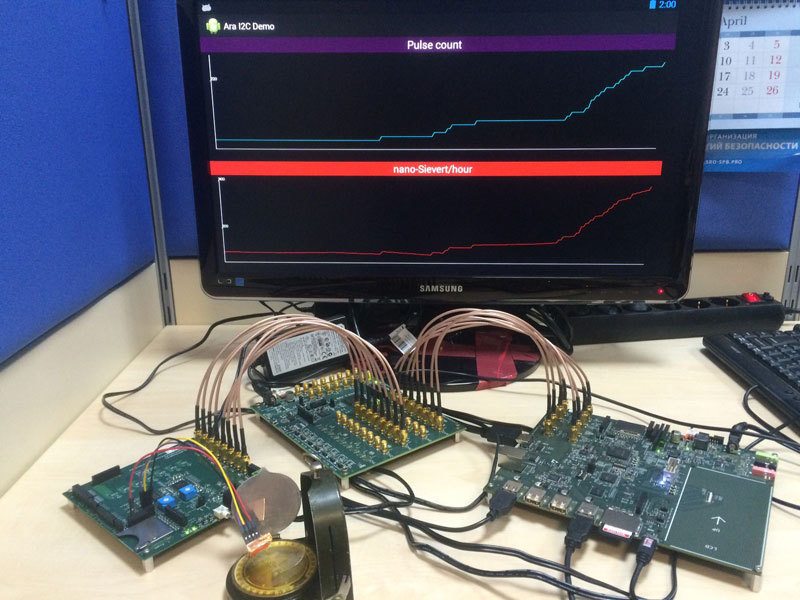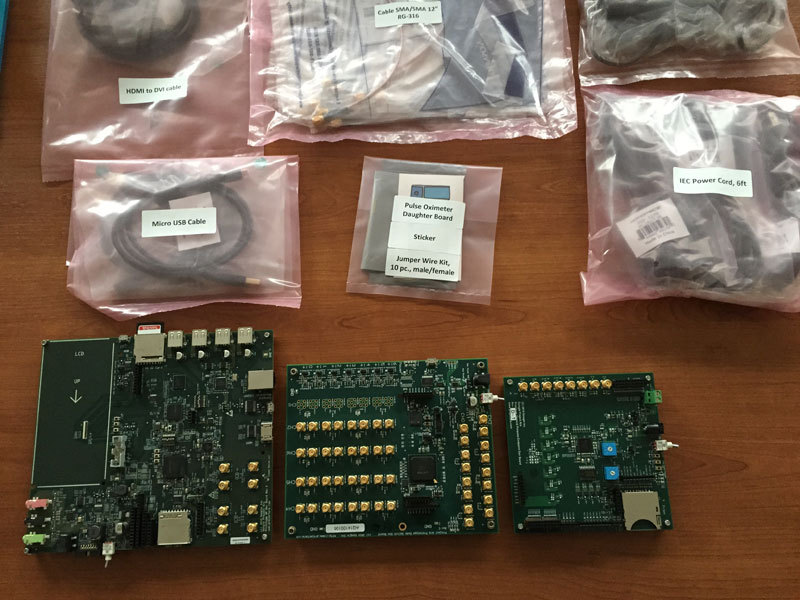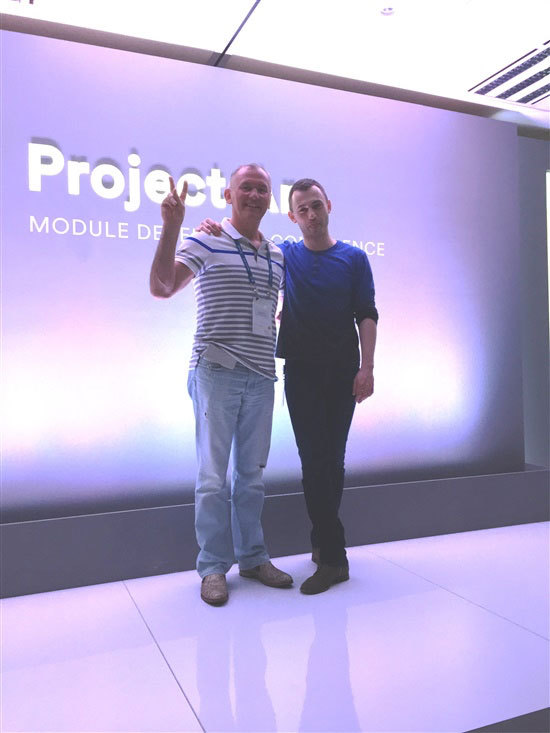Ara, yes? Or the modular smartphone of the future
In late January, a conference dedicated to Project Ara was held in Singapore.
Fans of designers will be interested to learn about the fresh state of the project, and I remind the rest of the readers that Project Google Ara (I did not invent the name) is a modular smartphone of the future, in which the user chooses components not only by cost, but also by functionality.

The work of the future smartphone with a radiation measurement module.
')
Conference topics: current state of Project Ara, plans to market a modular Ara smartphone, change of the Spiral hardware platform, management and design software, presentation of developer modules, developer support program, smartphone sales channels and modules for it.
We attended the conference as officially recognized developers of our own device DO-RA.Module.
Next, in order.
In the middle of December, we received a developer KIT (motherboard of Ara smartphone) from Google.

Development kit modular smartphone Spiral -1. From left to right - processor module, hub, I2C-gateway.
The hardest part was correctly connecting the wires to the hub. As normal programmers, the manual did not read. With the move did not work.
I had to read and twist 12 wires out of 16. Twisting the BNC plugs was the most difficult task in mastering Spiral. Everything else is much simpler. All the rest is to run with the test sensor (heart rate sensor attached) the entire system. Then we replaced the test sensor with a DO-PA sensor and rewrote the software under our I2C protocol.
And with all this compact system we flew to Singapore.
So, in Singapore, we brought three working modules DO-RA.Module-1, 2, 3, differing only in dimensions: 39x17x7 mm, 27x17x7 mm, and the most compact of them is 18x18x3.5 mm.

On the photo for the scale of products there was a quater (25 cents), but someone stole it.
Finish the quarter in the upper right corner.
We also have DO-RA.Soft software for the Android platform for managing our own module for analyzing the radiation situation and measuring the excess ionizing radiation around us. These modules can be mounted in various electronic devices to monitor and signal the level of radiation in the environment.
The conference was opened by the head of Project Ara, Paul Eremenko, who arrived here from the USA.

Glavkosmos , banned in Habré until 2016, and Paul Eremenko.
During the conference, about two dozen reports were made by the leaders and developers of Project Ara, electronics and software manufacturers, in particular: Toshiba, Marvell, Foxconn Interconnect, Quanta Computer, Synopsys, IDT on the stated topics. The information provided was useful, now we understand in detail the essence of the Ara project and, I hope, we keep up with the key players and developers of the Ara modules, without lagging over the design of the device and the software.
As it seems to us, a modular smartphone is still more exotic and partly a research project for understanding user preferences, the hidden essence of which is, perhaps, the definition of the most interesting modular developments for future smartphones. It is possible that in the near future, the most outstanding electronic modules for our lives will become the standard for the smartphone industry and will be placed as regular components in all new smartphones. So, at one time, the photo camera for the phone was at first exotic, but now they plan to install several photo / video cameras on one smartphone.
From the point of view of the openness of the developer platform, Google performed a miracle by opening its platform for free and equipping all willing developers with developer tools and programs. For example, a couple of years ago, in order to participate in a similar development, the same Qualcomm could ask the developer for an ordinary developer license for his chipsets up to $ 3 million. Feel the difference ?!
At the conference in Singapore, it was announced that from January 25, 2015, the accredited developers of the Ara project will be provided with the new Spiral-2 platform with MDK 0.2, which has a large number of interfaces and technical capabilities, and in the second quarter of 2015, Spiral-3 will be released c MDK 0.5. By the end of the year, Google in the framework of Project Ara plans to launch a pilot project of a workable modular smartphone with 20-30 modules that have passed the technical tests and certification. It is assumed that the test volume of modular smartphones, about 50 thousand units, will be released by the end of this year. And the testing zone is chosen Puerto Rico, where the maximum percentage of smartphones among the population, the widespread penetration of the Internet and the American standards for cellular communication operators.
Regarding the Google prize of $ 100K for the development of the most outstanding module for the Ara smartphone, it was noted that due to technical delays in the supply of Spiral-1 and Spiral-2, the submission of applications for participation in the competition was extended until March 1, video clips about the development of modules should be submitted April 15, summing up the competition for the best module for Ara will be held until May 1, 2015.
Of the real components for the Ara smartphone, a module from Vestigen from Slovakia was also presented at the conference. The announced module allows you to make rapid analyzes of the composition of liquid media, including blood tests and, in particular, monitor the level of insulin.
The results of the conference for JSC Intersoft Eurasia:
1. Obtained reliable information about the current status of Project Ara / Google directly from its developers and ideologues, which allows you to synchronize plans for the development and commercialization of DO-RA.Module for a modular Ara smartphone.
2. Direct contacts have been established with the Project Ara manager, Mr. Paul Eremenko and his team, as well as with the manufacturers of components of the promising modules for the Ara smartphone, represented by representatives of the companies: Toshiba, Marvell, Foxconn, Quanta Computer, etc.
Thanks for attention.
Fans of designers will be interested to learn about the fresh state of the project, and I remind the rest of the readers that Project Google Ara (I did not invent the name) is a modular smartphone of the future, in which the user chooses components not only by cost, but also by functionality.

The work of the future smartphone with a radiation measurement module.
')
Conference topics: current state of Project Ara, plans to market a modular Ara smartphone, change of the Spiral hardware platform, management and design software, presentation of developer modules, developer support program, smartphone sales channels and modules for it.
We attended the conference as officially recognized developers of our own device DO-RA.Module.
Next, in order.
In the middle of December, we received a developer KIT (motherboard of Ara smartphone) from Google.

Development kit modular smartphone Spiral -1. From left to right - processor module, hub, I2C-gateway.
The hardest part was correctly connecting the wires to the hub. As normal programmers, the manual did not read. With the move did not work.
I had to read and twist 12 wires out of 16. Twisting the BNC plugs was the most difficult task in mastering Spiral. Everything else is much simpler. All the rest is to run with the test sensor (heart rate sensor attached) the entire system. Then we replaced the test sensor with a DO-PA sensor and rewrote the software under our I2C protocol.
A piece of code, with three comments
package com.google.araploxio; import android.content.Context; import android.hardware.I2cManager; import android.hardware.I2cTransaction; import android.os.Handler; import android.util.Log; import java.io.IOException; import java.util.concurrent.Executors; import java.util.concurrent.ScheduledExecutorService; import java.util.concurrent.TimeUnit; public class Sensor { // The 7-bit slave address private static final int address = 0x11; private static final String bus = "/dev/i2c-4"; private Context context; private I2cManager i2c; private Handler handler; private ScheduledExecutorService executor = Executors.newScheduledThreadPool(1); ////////////////////////////////////////////////////////////////////////////////////////////////// // // // private static final I2cTransaction[] totalCountRead = { I2cTransaction.newWrite(0x02), I2cTransaction.newRead(2) }; private static final I2cTransaction[] radiatoinRead = { I2cTransaction.newWrite(0x04), I2cTransaction.newRead(2) }; ////////////////////////////////////////////////////////////////////////////////////////////////// // // // public Sensor(Context context, Handler handler) { this.context = context; this.i2c = (I2cManager)context.getSystemService("i2c"); this.handler = handler; } private I2cTransaction[] execute(I2cTransaction[] txns) { I2cTransaction[] results; try { results = null; for (I2cTransaction txn: txns) results = i2c.performTransactions(bus, address, txn); } catch (IOException e) { throw new RuntimeException("I2C error: " + e); } return results; } public void start() { executor.scheduleAtFixedRate(collector, 500, 500, TimeUnit.MILLISECONDS); } public void stop() { executor.shutdown(); try { executor.awaitTermination(500, TimeUnit.MILLISECONDS); } catch (InterruptedException e) { assert false; } } ////////////////////////////////////////////////////////////////////////////////////////////////// // // , // private final Runnable collector = new Runnable() { public void run() { I2cTransaction[] results; byte[] data; results = execute(totalCountRead); data = results[0].data; int count = (((int)data[1] & 0xFF) << 8) | (((int)data[0] & 0xFF) << 0); results = execute(radiatoinRead); data = results[0].data; int radiation = (((int)data[1] & 0xFF) << 8) | (((int)data[0] & 0xFF) << 0); Log.d("DORA", "count =" + count + " radiation = " + radiation); handler.obtainMessage(0, count, radiation).sendToTarget(); } }; } And with all this compact system we flew to Singapore.
So, in Singapore, we brought three working modules DO-RA.Module-1, 2, 3, differing only in dimensions: 39x17x7 mm, 27x17x7 mm, and the most compact of them is 18x18x3.5 mm.

On the photo for the scale of products there was a quater (25 cents), but someone stole it.
Finish the quarter in the upper right corner.
We also have DO-RA.Soft software for the Android platform for managing our own module for analyzing the radiation situation and measuring the excess ionizing radiation around us. These modules can be mounted in various electronic devices to monitor and signal the level of radiation in the environment.
The conference was opened by the head of Project Ara, Paul Eremenko, who arrived here from the USA.

Glavkosmos , banned in Habré until 2016, and Paul Eremenko.
During the conference, about two dozen reports were made by the leaders and developers of Project Ara, electronics and software manufacturers, in particular: Toshiba, Marvell, Foxconn Interconnect, Quanta Computer, Synopsys, IDT on the stated topics. The information provided was useful, now we understand in detail the essence of the Ara project and, I hope, we keep up with the key players and developers of the Ara modules, without lagging over the design of the device and the software.
As it seems to us, a modular smartphone is still more exotic and partly a research project for understanding user preferences, the hidden essence of which is, perhaps, the definition of the most interesting modular developments for future smartphones. It is possible that in the near future, the most outstanding electronic modules for our lives will become the standard for the smartphone industry and will be placed as regular components in all new smartphones. So, at one time, the photo camera for the phone was at first exotic, but now they plan to install several photo / video cameras on one smartphone.
From the point of view of the openness of the developer platform, Google performed a miracle by opening its platform for free and equipping all willing developers with developer tools and programs. For example, a couple of years ago, in order to participate in a similar development, the same Qualcomm could ask the developer for an ordinary developer license for his chipsets up to $ 3 million. Feel the difference ?!
At the conference in Singapore, it was announced that from January 25, 2015, the accredited developers of the Ara project will be provided with the new Spiral-2 platform with MDK 0.2, which has a large number of interfaces and technical capabilities, and in the second quarter of 2015, Spiral-3 will be released c MDK 0.5. By the end of the year, Google in the framework of Project Ara plans to launch a pilot project of a workable modular smartphone with 20-30 modules that have passed the technical tests and certification. It is assumed that the test volume of modular smartphones, about 50 thousand units, will be released by the end of this year. And the testing zone is chosen Puerto Rico, where the maximum percentage of smartphones among the population, the widespread penetration of the Internet and the American standards for cellular communication operators.
Regarding the Google prize of $ 100K for the development of the most outstanding module for the Ara smartphone, it was noted that due to technical delays in the supply of Spiral-1 and Spiral-2, the submission of applications for participation in the competition was extended until March 1, video clips about the development of modules should be submitted April 15, summing up the competition for the best module for Ara will be held until May 1, 2015.
Of the real components for the Ara smartphone, a module from Vestigen from Slovakia was also presented at the conference. The announced module allows you to make rapid analyzes of the composition of liquid media, including blood tests and, in particular, monitor the level of insulin.
The results of the conference for JSC Intersoft Eurasia:
1. Obtained reliable information about the current status of Project Ara / Google directly from its developers and ideologues, which allows you to synchronize plans for the development and commercialization of DO-RA.Module for a modular Ara smartphone.
2. Direct contacts have been established with the Project Ara manager, Mr. Paul Eremenko and his team, as well as with the manufacturers of components of the promising modules for the Ara smartphone, represented by representatives of the companies: Toshiba, Marvell, Foxconn, Quanta Computer, etc.
Thanks for attention.
Source: https://habr.com/ru/post/250723/
All Articles